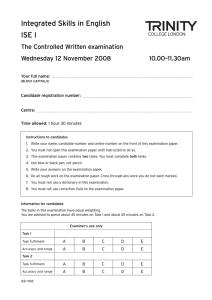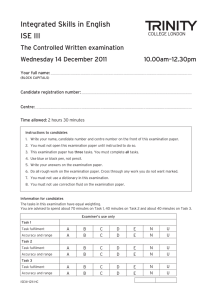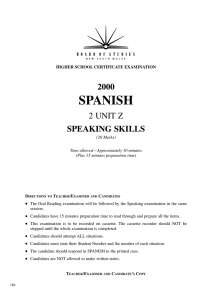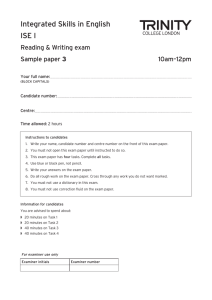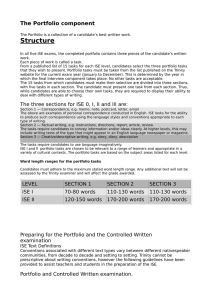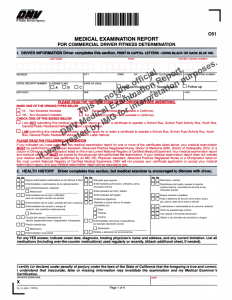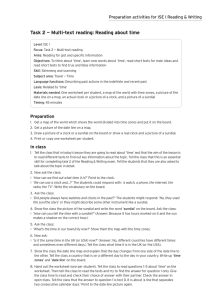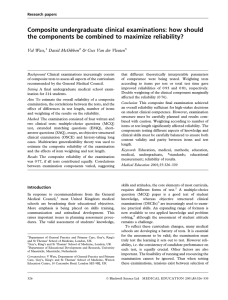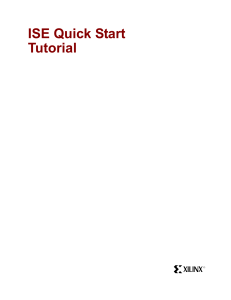Sample ISE IV Controlled Written exam paper 2
Anuncio
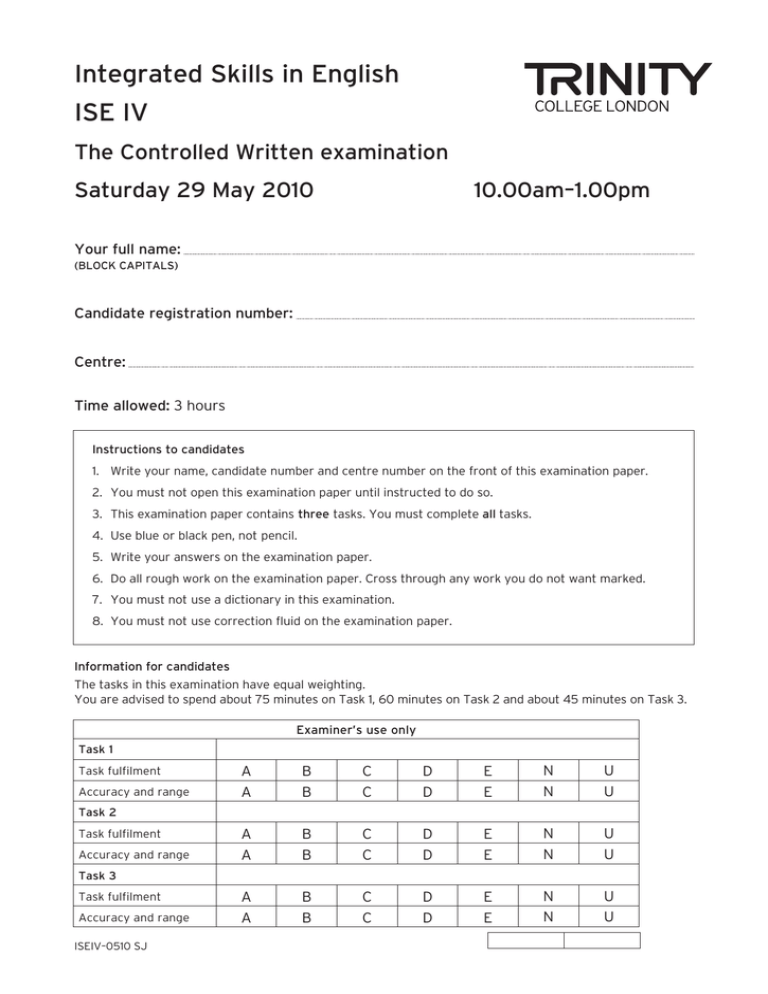
Integrated Skills in English ISE IV The Controlled Written examination Saturday 29 May 2010 10.00am–1.00pm Your full name: (block capitals) Candidate registration number: Centre: Time allowed: 3 hours Instructions to candidates 1. Write your name, candidate number and centre number on the front of this examination paper. 2. You must not open this examination paper until instructed to do so. 3. This examination paper contains three tasks. You must complete all tasks. 4. Use blue or black pen, not pencil. 5. Write your answers on the examination paper. 6. Do all rough work on the examination paper. Cross through any work you do not want marked. 7. You must not use a dictionary in this examination. 8. You must not use correction fluid on the examination paper. Information for candidates The tasks in this examination have equal weighting. You are advised to spend about 75 minutes on Task 1, 60 minutes on Task 2 and about 45 minutes on Task 3. Examiner’s use only Task 1 Task fulfilment Accuracy and range A A B B C C D D E E N N U U A A B B C C D D E E N N U U A A B B C C D D E E N N U U Task 2 Task fulfilment Accuracy and range Task 3 Task fulfilment Accuracy and range ISEIV–0510 SJ 29 May 2010 ISE IV Integrated Skills in English IV Time allowed: 3 hours This examination paper contains three tasks. You must complete all tasks. Task 1 — Reading into writing task — text synthesis Read the information below. Then, in your own words, write a report (approximately 350 words) for a record label: i) critically evaluating the importance of the piracy problem in the music industry in Britain and ii)discussing how far the fact that ‘knowing something is illegal is no longer a deterrent’ raises serious moral implications. 95% of youngsters are illegally copying music More than half of young people copy the songs on their hard drives from friends and even more swap copied CDs. Three decades after cassette decks first allowed people to make free music tapes for friends, the industry group British Music Rights (BMR) suggests home copying remains just as ingrained in UK culture. BMR’s chief executive said the research underlines the urgent need to adapt to consumers’ attitudes or face serious repercussions for the next generation of musicians. The industry’s anti-piracy efforts have largely focused on illegal online music swapping — with estimates suggesting only one in 20 digital downloads is paid for. But the online problem is potentially dwarfed by offline copying, argues BMR, which lobbies on behalf of composers, songwriters and music publishers. Many record label executives see the piracy problem getting worse before it gets better. The BMR research echoes other studies, signalling that knowing something is illegal is no longer a deterrent. The study was carried out against the backdrop of government deliberations over how to introduce an exception in law so that people can legally copy music they have bought for private use. The music industry says it accepts consumers should not be punished for shifting music from one format to another, but some are concerned an exception will increase the perception music can be freely copied with impunity. BMR has no problem in principle with the concept of changing the law but is urging the government to look to European law, which dictates that where a private copying-style exception is created there is also some sort of compensation for the creators and performers. The BMR says, ‘At some point musicians have to make money out of it otherwise they’ll stop doing it. Most musicians do it for the love and don’t see a penny. Maybe if they don’t get paid we’ll get rid of the ones doing it for money and our musical culture will be a far better and more creative place.’ Use your own words as far as possible. No marks for answers copied from the reading texts. You must make reference to both the text and the graphic information in your answer. page 2 This examination paper contains three tasks. You must complete all tasks. 29 May 2010 ISE IV Forms of copying 95% 85% 59% Copying by age group 90% 80 70 60 50 40 30 20 10 0 14–17 58% Your hard drive to friend’s hard drive Does copy 18–24 Friend’s hard drive to your hard drive 55% Send music files to friends Hard drive to CD CD to hard drive, CDR, MP3 Some form of copying 72% Does not copy 25+ Music not paid for in the average personal music collection by age group MP3 60% CD 50 40 30 20 10 0 14–17 18–24 25+ (Source: Adapted from the Guardian) Turn over page page 3 29 May 2010 page 4 ISE IV This examination paper contains three tasks. You must complete all tasks. 29 May 2010 ISE IV Turn over page page 5 29 May 2010 page 6 ISE IV This examination paper contains three tasks. You must complete all tasks. 29 May 2010 ISE IV Turn over page page 7 29 May 2010 page 8 ISE IV This examination paper contains three tasks. You must complete all tasks. 29 May 2010 ISE IV Task 2 — Reading into writing task — text transformation Read the text below. Then, in your own words, present the information given as a modern, colloquial version of the extract (approximately 300 words) for a teenage publication, which will appeal to young readers and motivate them to read more Sherlock Holmes adventures. Adventures of Sherlock Holmes: The Adventure of the Speckled Band Of the seventy odd cases in which I have, during the last eight years, studied the methods of my friend Sherlock Holmes, I cannot recall any which presented more unusual features than that which was associated with the well-known Surrey family of the Roylotts. It was early in April in the year ’83 that I woke one morning to find Sherlock Holmes standing, fully dressed, by the side of my bed. ‘Very sorry to knock you up, Watson,’ said he. ‘What is it, then — a fire?’ ‘No. A client. It seems that a young lady has arrived in a considerable state of excitement, who insists upon seeing me. She is waiting now.’ I rapidly threw on my clothes and was ready in a few minutes to accompany my friend down to the sitting-room. A lady, dressed in black and heavily veiled, rose as we entered. ‘Good-morning, madam,’ said Holmes cheerily. ‘Ha! I am glad to see that Mrs. Hudson has had the good sense to light the fire. Pray draw up to it, and I shall order you a cup of hot coffee, for I observe that you are shivering.’ ‘It is not cold which makes me shiver,’ said the woman in a low voice. ‘What, then?’ ‘It is fear, Mr. Holmes. It is terror,’ She raised her veil as she spoke, and we could see that she was indeed in a pitiable state of agitation, her face all drawn and grey, with restless frightened eyes, like those of some hunted animal. Sherlock Holmes ran her over with one of his quick, all-comprehensive glances. ‘You must not fear,’ said he soothingly. ‘You have come in by train this morning, I see.’ ‘You know me, then?’ ‘No, but I observe the second half of a return ticket in the palm of your left glove. You must have started early, and yet you had a long drive in a cart, along heavy roads, before you reached the station.’ (Source: Adapted from www.literaturepage.com) Turn over page page 9 29 May 2010 page 10 ISE IV This examination paper contains three tasks. You must complete all tasks. 29 May 2010 ISE IV Turn over page page 11 29 May 2010 page 12 ISE IV This examination paper contains three tasks. You must complete all tasks. 29 May 2010 ISE IV Turn over page page 13 29 May 2010 page 14 ISE IV This examination paper contains three tasks. You must complete all tasks. 29 May 2010 ISE IV Task 3 — Critical and analytical writing task ‘Imitation is the sincerest form of flattery.’ (Charles Caleb Colton, 1780–1832, writer) Write an essay (approximately 250 words) discussing how far you think this quotation is true today, and saying what other forms of flattery are routinely practised, with examples from your own experience. Turn over page page 15 29 May 2010 page 16 ISE IV This examination paper contains three tasks. You must complete all tasks. 29 May 2010 ISE IV Turn over page page 17 29 May 2010 page 18 ISE IV This examination paper contains three tasks. You must complete all tasks. 29 May 2010 ISE IV Turn over page page 19 29 May 2010 ISE IV End of examination Copyright © 2010 Trinity College London
